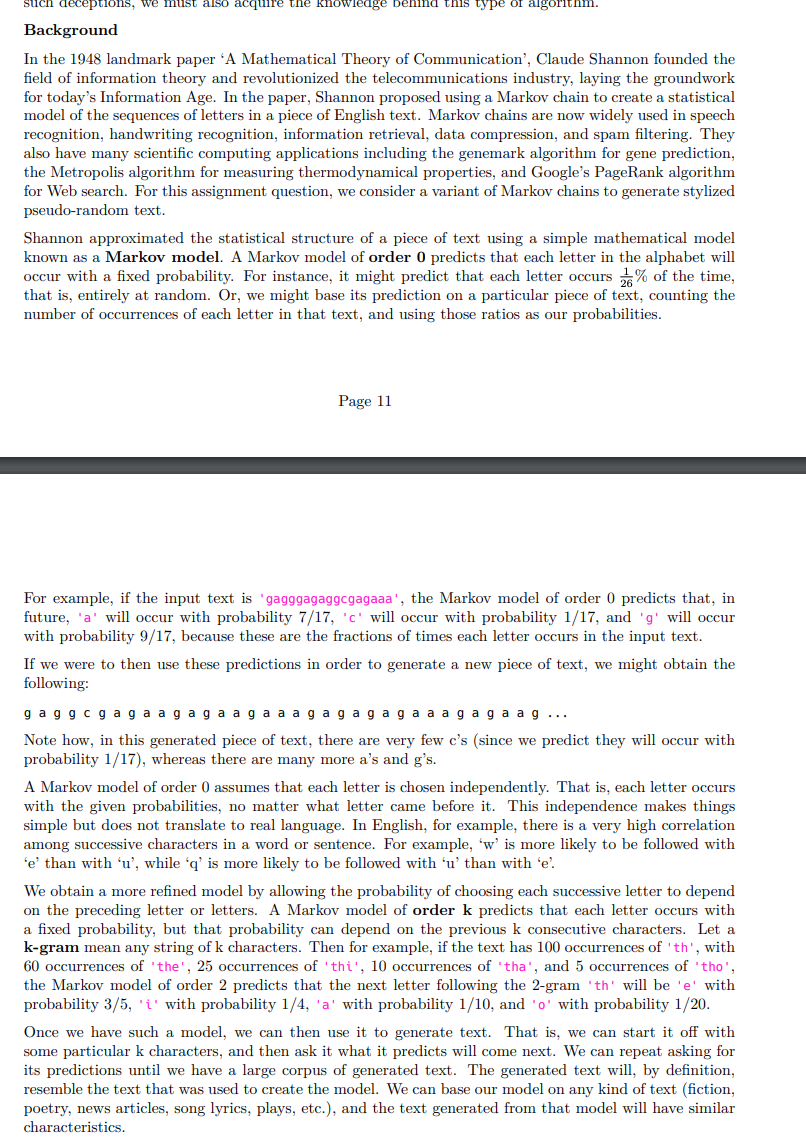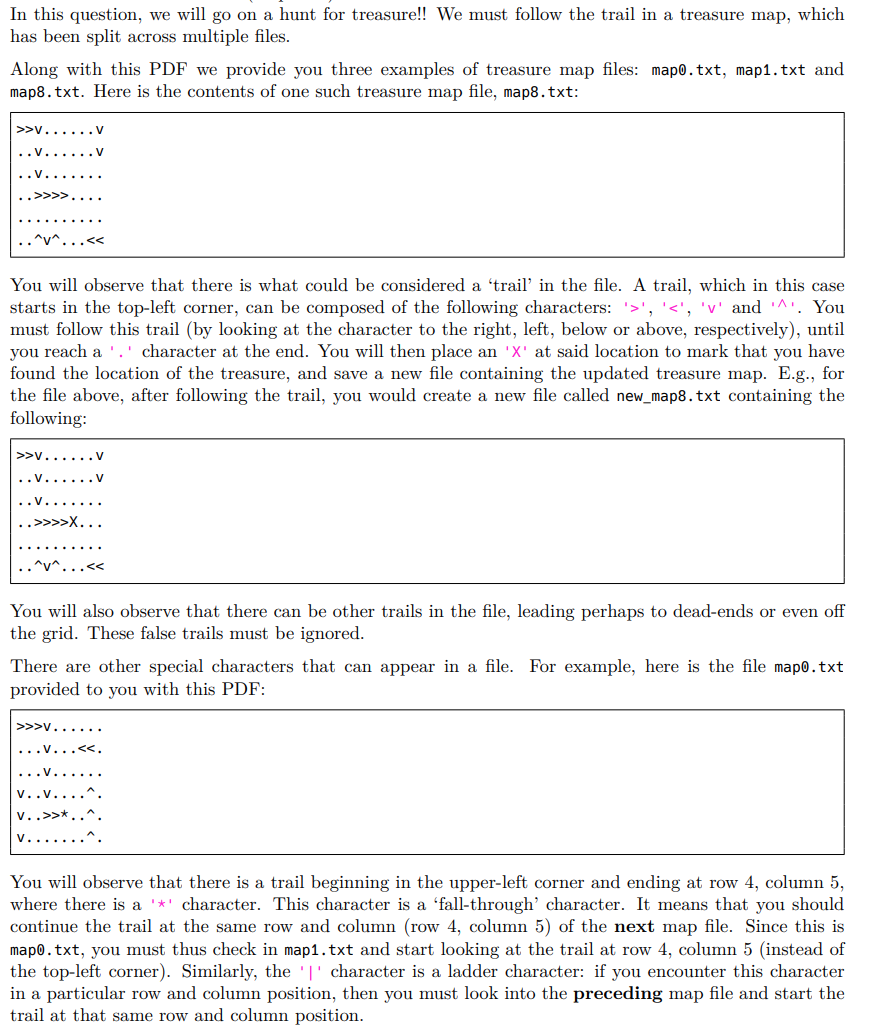Please help me write the following function (please see the attached photos for context of the problem): find_treasure(start_map_num): Takes an integer between 0 and 9 as input. Loads the corresponding map file, and starts following the trail (at position 0, 0 of that file) as described above. Continues following the trail through other map files as needed. Places an 'X' at the conclusion of the trail and saves the updated treasure map to a new file with 'new_' prepended to the current map filename. Returns a tuple of the row and column index where the 'X' was placed in that file.
Please help me write the following function (please see the attached photos for context of the problem): find_treasure(start_map_num): Takes an integer between 0 and 9 as input. Loads the corresponding map file, and starts following the trail (at position 0, 0 of that file) as described above. Continues following the trail through other map files as needed. Places an 'X' at the conclusion of the trail and saves the updated treasure map to a new file with 'new_' prepended to the current map filename. Returns a tuple of the row and column index where the 'X' was placed in that file.
Database System Concepts
7th Edition
ISBN:9780078022159
Author:Abraham Silberschatz Professor, Henry F. Korth, S. Sudarshan
Publisher:Abraham Silberschatz Professor, Henry F. Korth, S. Sudarshan
Chapter1: Introduction
Section: Chapter Questions
Problem 1PE
Related questions
Question
Please help me write the following function (please see the attached photos for context of the problem):
find_treasure(start_map_num):
Takes an integer between 0 and 9 as input. Loads the corresponding map file, and starts following the trail (at position 0, 0 of that file) as described above. Continues following the trail through other map files as needed. Places an 'X' at the conclusion of the trail and saves the updated treasure map to a new file with 'new_' prepended to the current map filename. Returns a tuple of the row and column index where the 'X' was placed in that file.

Transcribed Image Text:such deceptions, we must also acquire the knowiedge benind this type of algorithnm.
Background
In the 1948 landmark paper 'A Mathematical Theory of Communication', Claude Shannon founded the
field of information theory and revolutionized the telecommunications industry, laying the groundwork
for today's Information Age. In the paper, Shannon proposed using a Markov chain to create a statistical
model of the sequences of letters in a piece of English text. Markov chains are now widely used in speech
recognition, handwriting recognition, information retrieval, data compression, and spam filtering. They
also have many scientific computing applications including the genemark algorithm for gene prediction,
the Metropolis algorithm for measuring thermodynamical properties, and Google's PageRank algorithm
for Web search. For this assignment question, we consider a variant of Markov chains to generate stylized
pseudo-random text.
Shannon approximated the statistical structure of a piece of text using a simple mathematical model
known as a Markov model. A Markov model of order 0 predicts that each letter in the alphabet will
occur with a fixed probability. For instance, it might predict that each letter occurs % of the time,
that is, entirely at random. Or, we might base its prediction on a particular piece of text, counting the
number of occurrences of each letter in that text, and using those ratios as our probabilities.
Page 11
For example, if the input text is 'gagggagaggcgagaaa', the Markov model of order 0 predicts that, in
future, 'a' will occur with probability 7/17, 'c' will occur with probability 1/17, and 'g' will occur
with probability 9/17, because these are the fractions of times each letter occurs in the input text.
If we were to then use these predictions in order to generate a new piece of text, we might obtain the
following:
g agg cg ag a ag aga aga a a gag agaga a ag ag a ag ...
Note how, in this generated piece of text, there are very few c's (since we predict they will occur with
probability 1/17), whereas there are many more a's and g's.
A Markov model of order 0 assumes that each letter is chosen independently. That is, each letter occurs
with the given probabilities, no matter what letter came before it. This independence makes things
simple but does not translate to real language. In English, for example, there is a very high correlation
among successive characters in a word or sentence. For example, 'w' is more likely to be followed with
'e' than with 'u', while 'q' is more likely to be followed with 'u' than with 'e'.
We obtain a more refined model by allowing the probability of choosing each successive letter to depend
on the preceding letter or letters. A Markov model of order k predicts that each letter occurs with
a fixed probability, but that probability can depend on the previous k consecutive characters. Let a
k-gram mean any string of k characters. Then for example, if the text has 100 occurrences of 'th', with
60 occurrences of 'the', 25 occurrences of 'thi', 10 occurrences of 'tha', and 5 occurrences of 'tho',
the Markov model of order 2 predicts that the next letter following the 2-gram 'th' will be 'e' with
probability 3/5, 'i' with probability 1/4, 'a' with probability 1/10, and 'o' with probability 1/20.
Once we have such a model, we can then use it to generate text.
some particular k characters, and then ask it what it predicts will come next. We can repeat asking for
its predictions until we have a large corpus of generated text. The generated text will, by definition,
resemble the text that was used to create the model. We can base our model on any kind of text (fiction,
poetry, news articles, song lyrics, plays, etc.), and the text generated from that model will have similar
That is, we can start it off with
characteristics.

Transcribed Image Text:In this question, we will go on a hunt for treasure!! We must follow the trail in a treasure map, which
has been split across multiple files.
Along with this PDF we provide you three examples of treasure map files: map0.txt, map1.txt and
map8.txt. Here is the contents of one such treasure map file, map8.txt:
>>v......V
^v^.
You will observe that there is what could be considered a 'trail' in the file. A trail, which in this case
starts in the top-left corner, can be composed of the following characters: '>', '<', 'v' and '^'. You
must follow this trail (by looking at the character to the right, left, below or above, respectively), until
you reach a .' character at the end. You will then place an 'X' at said location to mark that you have
found the location of the treasure, and save a new file containing the updated treasure map. E.g., for
the file above, after following the trail, you would create a new file called new_map8.txt containing the
following:
>>v.
..v...... V
..>>>>X..
.^v^
You will also observe that there can be other trails in the file, leading perhaps to dead-ends or even off
the grid. These false trails must be ignored.
There are other special characters that can appear in a file. For example, here is the file map0.txt
provided to you with this PDF:
>>>v......
...v...
v..v.
v..>>*
You will observe that there is a trail beginning in the upper-left corner and ending at row 4, column 5,
where there is a '*' character. This character is a 'fall-through' character. It means that you should
continue the trail at the same row and column (row 4, column 5) of the next map file. Since this is
mapo.txt, you must thus check in map1.txt and start looking at the trail at row 4, column 5 (instead of
the top-left corner). Similarly, the '|' character is a ladder character: if you encounter this character
in a particular row and column position, then you must look into the preceding map file and start the
trail at that same row and column position.
Expert Solution
This question has been solved!
Explore an expertly crafted, step-by-step solution for a thorough understanding of key concepts.
This is a popular solution!
Trending now
This is a popular solution!
Step by step
Solved in 3 steps with 3 images

Knowledge Booster
Learn more about
Need a deep-dive on the concept behind this application? Look no further. Learn more about this topic, computer-science and related others by exploring similar questions and additional content below.Recommended textbooks for you

Database System Concepts
Computer Science
ISBN:
9780078022159
Author:
Abraham Silberschatz Professor, Henry F. Korth, S. Sudarshan
Publisher:
McGraw-Hill Education

Starting Out with Python (4th Edition)
Computer Science
ISBN:
9780134444321
Author:
Tony Gaddis
Publisher:
PEARSON

Digital Fundamentals (11th Edition)
Computer Science
ISBN:
9780132737968
Author:
Thomas L. Floyd
Publisher:
PEARSON

Database System Concepts
Computer Science
ISBN:
9780078022159
Author:
Abraham Silberschatz Professor, Henry F. Korth, S. Sudarshan
Publisher:
McGraw-Hill Education

Starting Out with Python (4th Edition)
Computer Science
ISBN:
9780134444321
Author:
Tony Gaddis
Publisher:
PEARSON

Digital Fundamentals (11th Edition)
Computer Science
ISBN:
9780132737968
Author:
Thomas L. Floyd
Publisher:
PEARSON

C How to Program (8th Edition)
Computer Science
ISBN:
9780133976892
Author:
Paul J. Deitel, Harvey Deitel
Publisher:
PEARSON

Database Systems: Design, Implementation, & Manag…
Computer Science
ISBN:
9781337627900
Author:
Carlos Coronel, Steven Morris
Publisher:
Cengage Learning

Programmable Logic Controllers
Computer Science
ISBN:
9780073373843
Author:
Frank D. Petruzella
Publisher:
McGraw-Hill Education